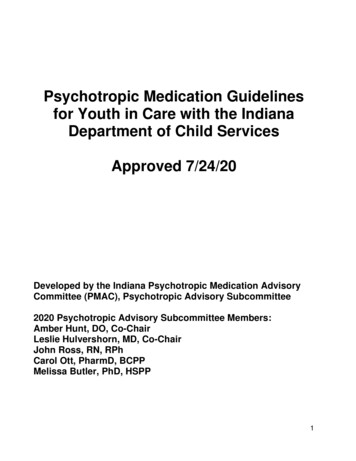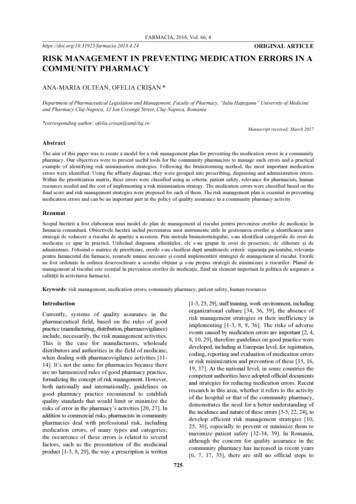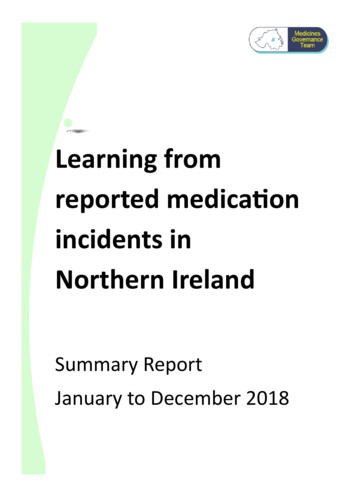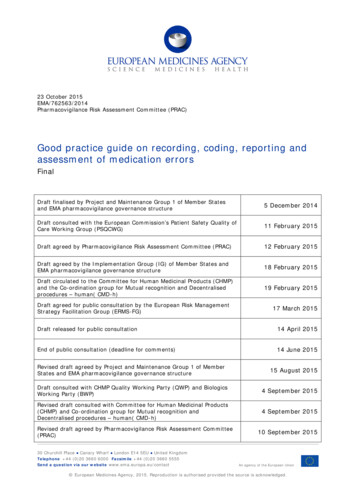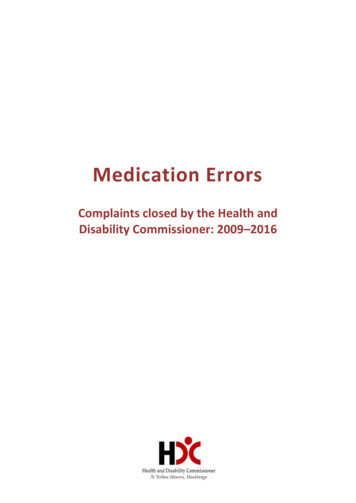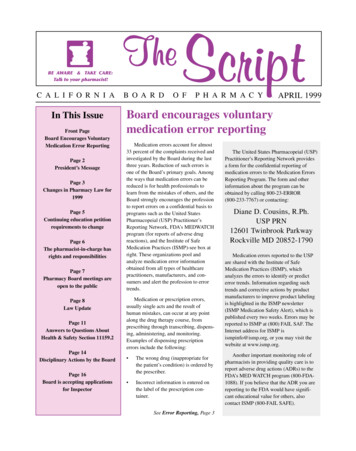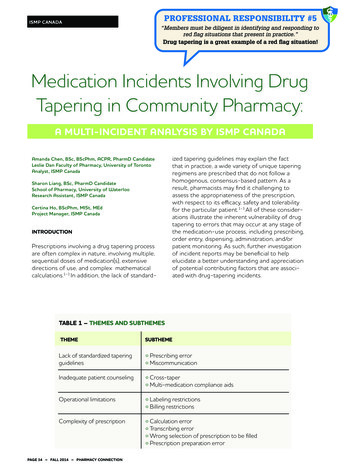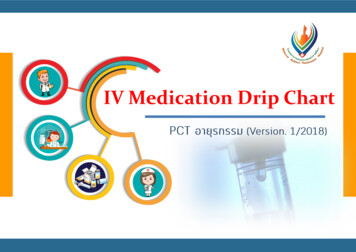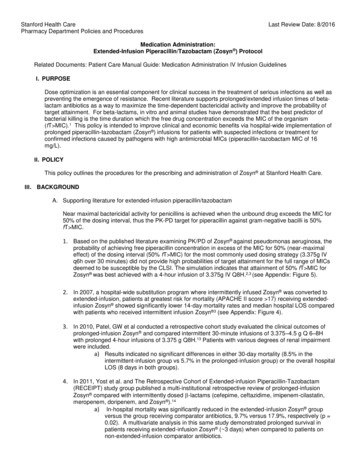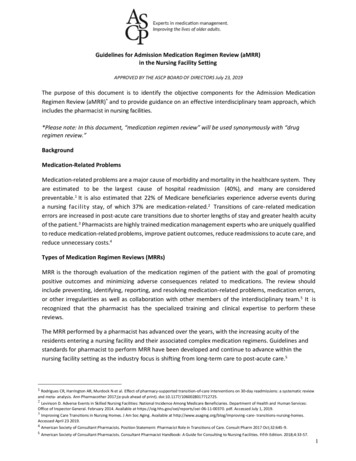
Transcription
Guidelines for Admission Medication Regimen Review (aMRR)in the Nursing Facility SettingAPPROVED BY THE ASCP BOARD OF DIRECTORS July 23, 2019The purpose of this document is to identify the objective components for the Admission MedicationRegimen Review (aMRR)* and to provide guidance on an effective interdisciplinary team approach, whichincludes the pharmacist in nursing facilities.*Please note: In this document, “medication regimen review” will be used synonymously with “drugregimen review.”BackgroundMedication-Related ProblemsMedication-related problems are a major cause of morbidity and mortality in the healthcare system. Theyare estimated to be the largest cause of hospital readmission (40%), and many are consideredpreventable.1 It is also estimated that 22% of Medicare beneficiaries experience adverse events duringa nursing facility stay, of which 37% are medication-related.2 Transitions of care-related medicationerrors are increased in post-acute care transitions due to shorter lengths of stay and greater health acuityof the patient.3 Pharmacists are highly trained medication management experts who are uniquely qualifiedto reduce medication-related problems, improve patient outcomes, reduce readmissions to acute care, andreduce unnecessary costs.4Types of Medication Regimen Reviews (MRRs)MRR is the thorough evaluation of the medication regimen of the patient with the goal of promotingpositive outcomes and minimizing adverse consequences related to medications. The review shouldinclude preventing, identifying, reporting, and resolving medication-related problems, medication errors,or other irregularities as well as collaboration with other members of the interdisciplinary team.5 It isrecognized that the pharmacist has the specialized training and clinical expertise to perform thesereviews.The MRR performed by a pharmacist has advanced over the years, with the increasing acuity of theresidents entering a nursing facility and their associated complex medication regimens. Guidelines andstandards for pharmacist to perform MRR have been developed and continue to advance within thenursing facility setting as the industry focus is shifting from long-term care to post-acute care.51 Rodrigues CR, Harrington AR, Murdock N et al. Effect of pharmacy-supported transition-of-care interventions on 30-day readmissions: a systematic reviewand meta- analysis. Ann Pharmacother 2017;(e-pub ahead of print). doi:10.1177/1060028017712725.2Levinson D. Adverse Events in Skilled Nursing Facilities: National Incidence Among Medicare Beneficiaries. Department of Health and Human Services:Office of Inspector General. February 2014. Available at https://oig.hhs.gov/oei/reports/oei-06-11-00370. pdf. Accessed July 1, 2019.3Improving Care Transitions in Nursing Homes. J Am Soc Aging. Available at http://www.asaging.org/blog/improving-care- transitions-nursing-homes.Accessed April 23 2019.4 American Society of Consultant Pharmacists. Position Statement: Pharmacist Role in Transitions of Care. Consult Pharm 2017 Oct;32:645-9.5 American Society of Consultant Pharmacists. Consultant Pharmacist Handbook: A Guide for Consulting to Nursing Facilities. Fifth Edition. 2018;4:33-57.1
A monthly review may no longer meet the needs of the resident or the nursing facility. The need for aprospective, concurrent, and/or retrospective MRR process by a pharmacist that is resident-centeredhas led to further defining the types of MRR that now exist (Table 1).Table 1. Types of MRRsAdmission MRR A review that is completed for a resident upon admission to the nursingfacilityMonthly MRR A review that is completed by a pharmacist on a monthly basis as required byregulatory requirementsChange of Condition A review that is completed by a pharmacist in the interim between monthlyreviews on a resident who may experience an acute change of condition or asrequested by another member of the interdisciplinary teamCenters for Medicare and Medicaid Services (CMS) State OperationsManual (SOM) MRRThe pharmacist MRR requirement as a condition of participation for a nursing facility in the Medicareprogram was promulgated in 1974. Several subsequent updates to the CMS SOM has expanded elementsof the MRR requirement, with the advancement of the pharmaceutical care6 concept and the increasingacuity of the residents entering a nursing facility. MRRs may now be required more frequently based onthe resident’s condition or the potential for adverse effects from medications. This includes short-stay (lessthan 30 days) or acute change of conditions MRRs.IMPACT ACT Drug Regimen ReviewThe IMPACT (Improving Medicare Post-Acute Care Transformation) Act of 2014 requires the reporting ofstandardized patient assessment data in regard to quality measures and standardized patient assessmentdata elements across all post-acute care settings.7 One of the original quality measure domains ismedication reconciliation. In 2018, the final rules for nursing facilities, inpatient-rehabilitation facilities,and long-term care hospitals for this measure were released for implementation. In the nursing facilitysetting, the requirements are defined in the MDS 3.0 Resident Assessment Instrument manual, whichdefined the medication reconciliation measure as a Drug Regimen Review (DRR) requirement that includesmedication reconciliation. The intent is to have a DRR conducted upon the resident’s admission to the6Hepler CD, Strand LM. Opportunities and responsibilities in pharmaceutical care. Am J Hosp Pharm. 1990;47:533–543.7IMPACT Act of 2014 Data Standardization & Cross Setting Measures .html2
nursing facility throughout the stay and to address any clinically significant medication issues in a timelymanner. This definition of DRR is not necessarily congruent with the existing SOM requirements for MRR.While the discipline that performs the DRR is not specified by the IMPACT Act, the pharmacist is the health carepractitioner most prepared to perform this function.Medication ReconciliationAccording to the Joint Commission, medication reconciliation is the process of comparing a patient’smedication orders to all of the medications the patient has been taking or should be taking.8 Thereconciliation is done to avoid unintended medication errors such as omissions, transcription, orduplication errors. This process is contingent on having two medication lists available to review at aminimum: one from the prior care setting or from the patient when the admission is from the community,and the other being the active medication list approved by the physician upon admission at the currentcare setting. The act of MRR may or may not include medication reconciliation, since these are twoseparate processes. It may also depend on the availability of the medication lists and the facility policy formedication reconciliation. Some facilities may choose to have medication reconciliation performed byanother member of the interdisciplinary team, and then the MRR performed by a pharmacist.The actual process of medication reconciliation may also be performed differently depending on theinterdisciplinary team member performing the medication reconciliation. For example, a nurse maycompare the prior settings medication list to the medication list approved by the attending physicianwithin a nursing facility. A prescriber (physician or nurse practitioner) may reconcile the patient’s activemedication orders during their stay prior to discharging them from the acute care facility. A pharmacistmay reconcile the medication list from the prior care setting to the current care setting’s active medicationorders and also perform MRR at the same time. These are two separate acts that can work in unison toensure the most accurate and safe medication regimen for the patient. The patient should always beconsulted, when practical, to ensure a patient-centered approach and to clarify medication discrepancies.Interdisciplinary Team in the aMRR ProcessASCP takes the position that the pharmacist is the lead discipline that can perform MRR most effectivelyin conjunction with the interdisciplinary team members who are also essential in achieving optimaloutcomes for the residents in their care. This section outlines the role of each member of theinterdisciplinary team during the aMRR.Role of the PharmacistThe senior care pharmacist should take the lead role in ensuring an effective aMRR process within thenursing facility. The actual aMRR process may be performed by this pharmacist or another appropriatelytrained designated pharmacist, which may include but is not limited to an operational pharmacist within adispensing pharmacy. In this case, it is essential that both pharmacists communicate regularly to identify8 The Joint Commission, National Patient Safety Goal 03.06.01. Available at https://www.jointcommission.org/standards information/npsgs.aspx, Accessed May 30,2018.3
urgent issues or trends that need to be addressed with the interdisciplinary team at the nursing facility.Regardless of the pharmacist model used, standard guidelines and essential elements to perform themshould be followed as further defined in this document.The basic acts of a pharmacist dispensing a medication from a pharmacy alone would not meet therequirements of an aMRR, although this service is a valuable first step in the process to ensure medicationsafety. Individual pharmacy State rules and regulations set the drug utilization review requirements of apharmacist when dispensing medications.The pharmacist performing the aMRR should communicate regularly with the facility nursing staff andhave a process to address clinically significant medication issues that need to be addressed in a timelymanner. Clinically significant medication issues have the potential for immediate harm to the resident,and the pharmacist should take immediate action to contact the nursing facility to resolve the issue. Thepharmacist should also be available to answer any questions and should contact the facility staff if furtherclarification is needed on any potential irregularities.The CMS SOM provides guidance for pharmacists and t h e minimal standards for medicationmanagement that must be met by each nursing facility. These include the definition of an unnecessarydrug and psychotropic drugs. The pharmacist performing the aMRR needs to be knowledgeable of theserequirements and guidelines.Pharmacists should provide guidance and regular reporting to the facility on process improvementopportunities as patterns or trends are identified during their aMRR process to improve the quality of careand outcomes to the residents.Role of the Facility Administration and NursingThe facility leadership (including nursing, administration, and the Monitored Dosage System [MDS]coordinator) are essential in the aMRR process. The facility should provide the pharmacist with theappropriate information to allow for a thorough MRR once the resident is admitted to the facility. Thisincludes access to any electronic health or medical record systems. Minimally, the pharmacist would needaccess to the resident’s medication orders, original discharge medication orders from the previous caresetting, diagnosis list (or face sheet), and any clinical documentation transferred from the previous caresetting.Facility nursing staff performing the admission process for a newly admitted resident also have a role inmedication safety when they confirm new medication orders with the attending physician. This shouldinclude a medication reconciliation of the medications from the previous care setting to the ordersreceived upon admission. Another verification step performed by another nurse should be performedwhen orders are entered into any electronic heath record system, to avoid transcription entry errors. Thisstep, while important, should not be considered a MRR due to the limitations of this review.Any irregularities found by the pharmacist need to be addressed in a timely manner, especially anyclinically significant issues. The facility must have a process in place to address any recommendationsmade by the pharmacist and a full understanding of the regulatory requirements and the potential impact4
on the clinical care of the resident. Facility staff must have frequent communication with the pharmacistcompleting the aMRR, the facility senior care pharmacist, and the resident’s medical provider to ensurerecommendations are addressed in a timely manner.The IMPACT Act requires all clinically significant medication issues to be addressed by the physician (ordesignee) by midnight of the next calendar day due to potential harm to the resident. There is alsopotential for decreased reimbursement (-2%) if the MDS section is not completed timely or codedincorrectly. The facility should have a policy and procedure and educational training for staff on theimportance of this process, and how to best communicate appropriate records to the MDS coordinator.Patterns or trends in medication-related problems should be addressed regularly at the facility qualityassurance and performance improvement meeting or other interdisciplinary team meeting.Interdisciplinary team members include, but are not limited to, the facility administrator, medical director,director of nursing, and senior care pharmacist.Role of the Medical Director and Medical Providers (Physician, CNP, PA)The facility medical director is a key member of the interdisciplinary team to ensure an effective aMRRprocess is in place at the nursing facility, to ensure recommendations are addressed timely, and to providemedical oversight of the processes to ensure positive outcomes. As part of the interdisciplinary care team,medical providers must also understand the aMRR process within a nursing facility as well as the
APPROVED BY THE ASCP BOARD OF DIRECTORS July 23, 2019 The purpose of this document is to identify the objective components for the Admission Medication Regimen Review (aMRR)* and to provide guidance on an effective interdisciplinary team approach, which includes the pharmacist in nursing facilities. *Please note: In this document, medication regimen review _ will be used synonymously with .
